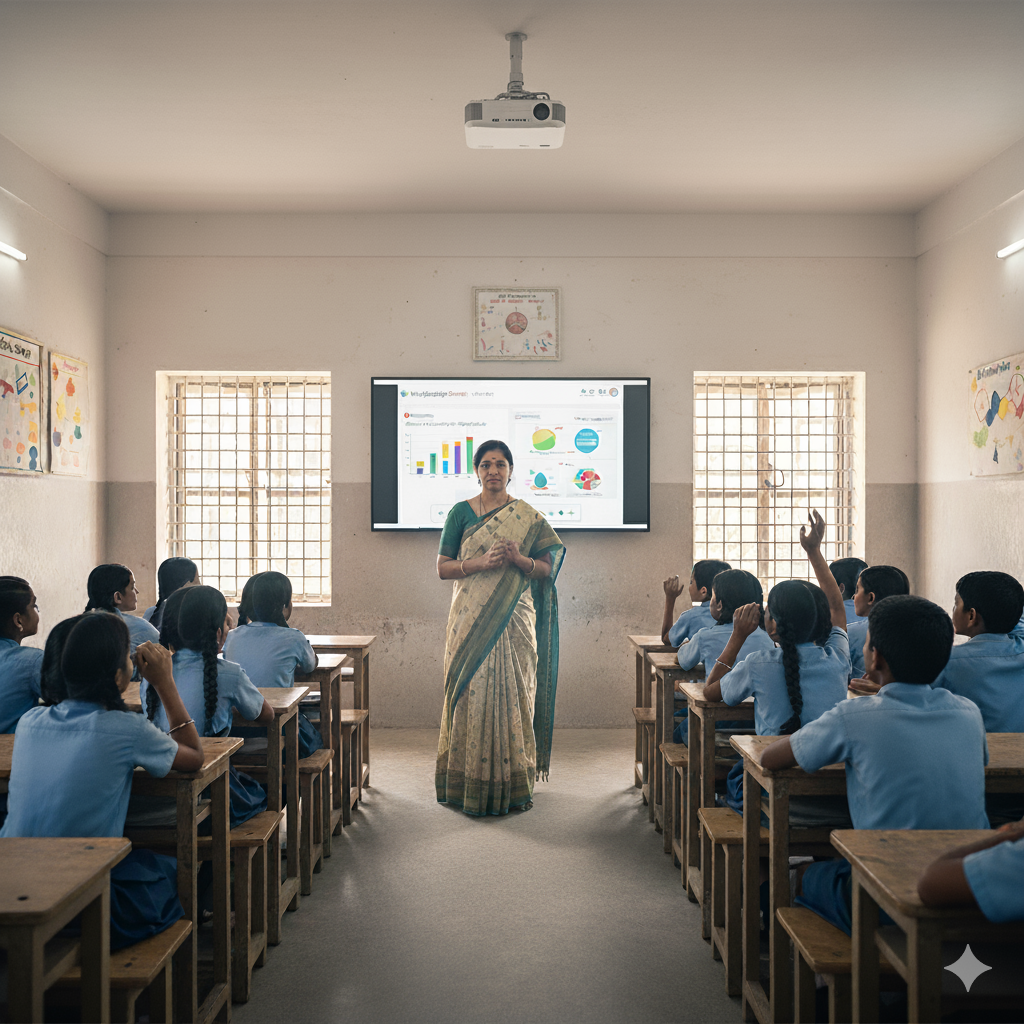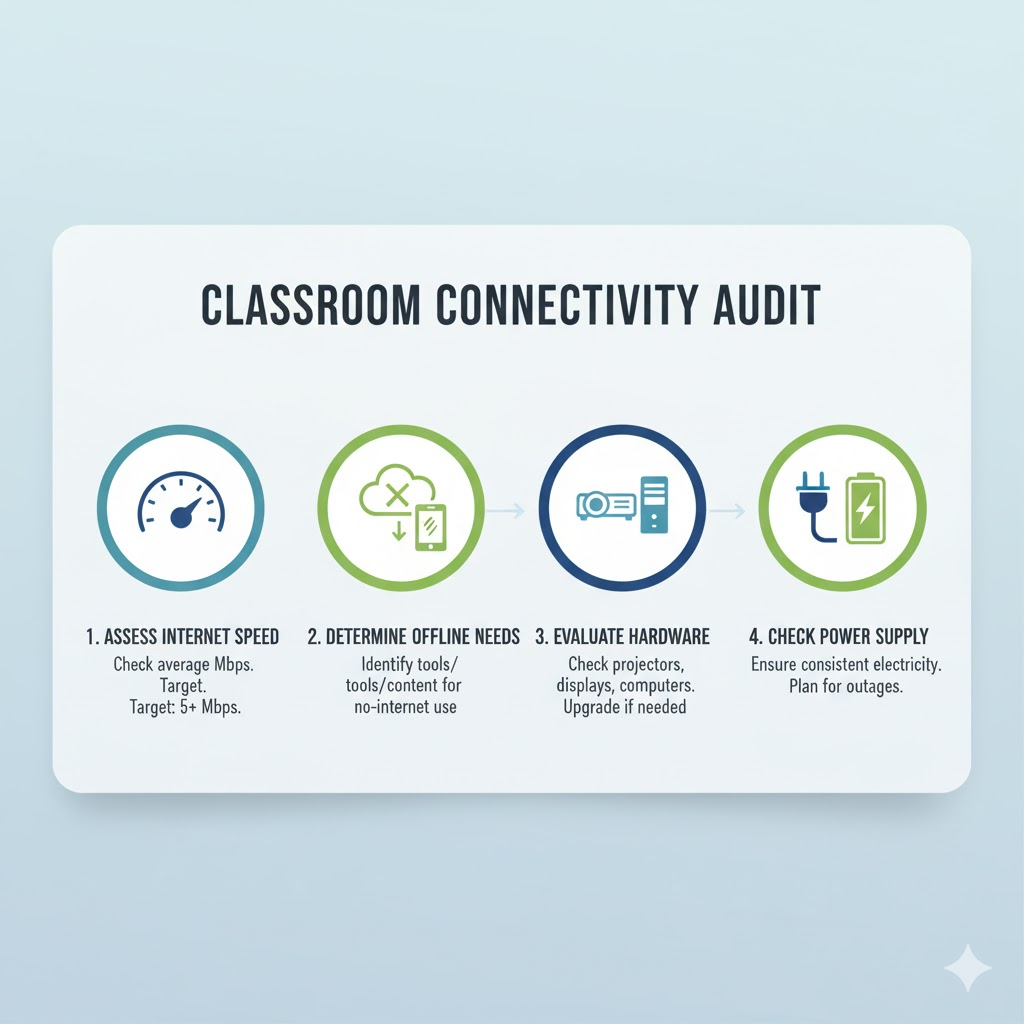Why Low-Bandwidth Digital Classroom Equipment is Important for Indian Schools

The rapid growth of technology in education has introduced innovative classroom solutions, transforming how teaching and learning take place. One of the most significant advancements in this area is the advent of digital classroom equipment, designed to enhance the learning experience. However, in India, especially in the rural regions, internet connectivity can be a challenge in many educational institutions. Hence, there is a growing demand for low-bandwidth digital classroom equipment that can function seamlessly in environments with limited internet access.
In this guide, we discuss what low-bandwidth educational equipment is. It includes why it is essential for Indian schools, and which tools are indispensable for creating a functional, immersive classroom experience with minimal reliance on high-speed internet.
What is Low-Bandwidth Digital Classroom Equipment?
Low-bandwidth digital classroom equipment refers to tools and devices that are optimized for educational use in environments with limited or inconsistent internet connectivity. These solutions are designed to work effectively with minimal bandwidth. It ensures that classrooms can still leverage the power of digital learning, even without high-speed internet.
Unlike traditional digital tools that require constant internet access for functioning, such as cloud-based platforms or streaming applications, low-bandwidth equipment is designed to operate offline or with intermittent online connectivity. This is particularly crucial in regions like rural India, where high-speed internet infrastructure is still being developed, but digital education is seen as the future of learning.
Why Low-Bandwidth Digital Classroom Equipment is Crucial for Indian Schools
India, with its vast geographical spread, diverse population, and varying access to reliable internet, faces unique challenges in digital education. The need for low-bandwidth digital classroom equipment arises from several factors:
1. Limited Internet Connectivity in Rural Areas
Many schools, especially those in rural or remote areas of India, struggle with unreliable or slow internet connections. This can hinder the implementation of modern educational tools that require stable and fast internet connections. By utilizing low-bandwidth solutions, schools can ensure that students and teachers still have access to digital resources without depending on an ideal internet environment.
2. Affordability and Cost Efficiency
The cost of maintaining high-speed internet infrastructure in every classroom can be prohibitive, especially for government and private educational institutions with limited budgets. Low-bandwidth equipment allows schools to make the most of available resources without needing to invest heavily in expensive internet services.
3. Offline Functionality for Seamless Learning
Low-bandwidth solutions often provide offline functionality, allowing teachers to deliver lessons and assignments without the need for a continuous internet connection. This is especially important for K-12 schools and higher education institutions in India, where daily disruptions in internet connectivity can affect learning outcomes.
4. Easing the Transition to Digital Learning
While many schools are transitioning to digital classrooms, especially in the wake of the COVID-19 pandemic, the shift can be challenging. Low-bandwidth solutions facilitate this transition by ensuring that both teachers and students can access resources and interact with each other without requiring constant access to the internet.
Simple Connectivity Audit: How to Ensure Your Classroom is Ready for Digital Learning

Before implementing any digital classroom equipment, it is crucial to perform a connectivity audit to assess the available internet resources. This audit will help you determine the type of equipment needed and identify areas where you might need additional resources.
Steps to Conduct a Connectivity Audit:
- Assess Internet Speed: Use speed tests to determine the average internet speed in the classroom. Ideally, a speed of at least 5 Mbps is recommended for basic digital classroom use, but this will vary based on the tools and content being used. Roombr is designed to deliver a smooth online class experience even when connection speeds are as low as 2 Mbps.
- Determine Offline Needs: Identify areas where offline functionality is required, especially in rural areas with intermittent internet connectivity.
- Evaluate Hardware: Assess the existing hardware, such as projectors, interactive displays, and computing units, to determine whether upgrades or replacements are needed.
- Check Power Supply: Ensure that the classroom has a consistent power supply to support digital tools, especially during power outages common in rural areas.
By understanding the current infrastructure and identifying gaps, schools can make informed decisions about the digital classroom tools they need.
Core Low-Bandwidth Digital Classroom Equipment Required
Creating an efficient digital classroom that functions well with low-bandwidth connectivity involves selecting the right equipment. Below are some essential tools that should be part of every low-bandwidth classroom setup:
1. Interactive Displays
Interactive displays are the heart of a modern digital classroom. They replace traditional blackboards with touch-enabled screens, allowing teachers to present dynamic lessons, display educational videos, and engage students interactively. Modern displays often come with offline features, enabling them to function effectively without relying heavily on internet connections.
These display panels can be connected to teaching aids like projectors, enabling educators to deliver multimedia lessons without depending on high-bandwidth internet.
2. High-Quality Cameras and Microphones
Even with low-bandwidth systems, capturing clear audio and video during lessons is crucial. Integrated cameras and microphones allow for the recording of live sessions, ensuring that lessons are documented and accessible for later review. Additionally, they enhance the remote learning experience by allowing teachers to communicate effectively with students in hybrid learning environments.
3. Computing Units
Powerful computing units are essential for running digital tools, whether offline or online. These systems should be capable of handling interactive learning software and other classroom applications. Additionally, they should come with storage capabilities to save lesson content, student assignments, and recorded sessions, reducing the need for constant internet access.
4. Offline Learning Management Systems (LMS)
An offline Learning Management System (LMS) enables teachers to upload and manage lesson plans, tests, assignments, and other educational content. Students can access these resources locally on their devices, ensuring that learning continues without a constant internet connection.
5. Assessment and Tracking Tools
Assessment tools that work offline help teachers to evaluate student progress even in low-connectivity environments. These tools can also be integrated with AI-enabled features to automatically grade assignments and provide feedback. Moreover, the ability to track student performance is essential for ensuring that learners are progressing as expected.
6. Portable Hotspots for Connectivity
In areas where even basic internet is unavailable, portable hotspots can help bridge the gap, ensuring that the classroom remains connected for essential updates or lesson sharing. However, these should be considered as supplementary devices when primary offline options are unavailable.
How Low-Bandwidth Digital Classroom Equipment Can Be Used by Teachers Offline
For teachers operating in a low-bandwidth classroom, the ability to function offline is critical. Here's how low-bandwidth classroom solutions can be utilized effectively:
- Offline Content Delivery: Teachers can download educational videos, lesson plans, and assignments in advance. These can be displayed on interactive displays or shared with students using USB drives or local network servers.
- Class Recording and Sharing: Recorded lessons can be saved on local devices and shared with students via offline channels, allowing them to revisit class content at any time.
- Assessments: Teachers can use offline assessment tools to grade assignments and provide feedback, without needing continuous internet access.
- Classroom Collaboration: Students can collaborate on projects and assignments using local network resources, encouraging interactive learning without relying on the internet.
Key Takeaway
As digital education continues to evolve, low-bandwidth digital classroom equipment offers a sustainable solution for schools in India, where internet connectivity is often inconsistent. By choosing the right equipment, educators can make sure that their students receive the benefits of modern education without being limited by the availability of high-speed internet. Whether it's interactive displays, offline LMS, or portable hotspots, the key to success lies in selecting tools that are versatile, cost-effective, and efficient in low-connectivity environments.
Frequently Asked Questions
1. What is the best equipment for low-bandwidth classrooms in India?
The best equipment includes interactive displays, computing units, offline learning management systems, and offline assessment tools. These tools are optimized for low-bandwidth environments, ensuring seamless learning experiences without relying on high-speed internet.
2. How can digital classroom tools be used offline in rural areas?
Digital tools like interactive displays and computing units can store content offline. This allows teachers to deliver lessons, record sessions, and assess student progress without needing constant internet access.
3. Can low-bandwidth digital classroom equipment work with limited internet speeds?
Yes, low-bandwidth equipment for a digital classroom is designed to function with minimal or fluctuating internet speeds, making it ideal for environments where high-speed internet is not available.
4. What are the benefits of low-bandwidth digital classroom solutions for Indian schools?
These solutions provide cost-effective, efficient, and accessible education, even in areas with limited connectivity. They also enable offline learning, ensuring continuity of education despite internet challenges.
5. How can schools ensure their infrastructure supports low-bandwidth digital classrooms?
Schools should conduct a connectivity audit to assess available internet speed, hardware, and power supply. This will help identify any gaps and ensure that the right digital equipment is selected for their needs.
Reimagine Classroom Learning with Roombr’s Digital Innovation
Roombr Digital Classroom offers an all-in-one solution with interactive displays, AI-enabled features, and offline functionality, providing a seamless learning experience for schools with limited internet access.
Learn more about how Roombr’s innovative technology can transform your classroom and support your educational goals. Visit Roombr Digital Classroom to explore our products and services tailored for K-12 and higher education institutions.
Foziya Abuwala
Share
Step Into the future of
Education with Roombr

















